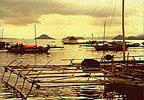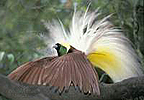|
Maluku lies across a transition zone
between Asian and Australian fauna and flora, and also between the
Malay-based cultures of western Indonesia and those of Melanesia.
there are over 1,000 islands in the Province most of which are uninhabited.
85% of Maluku is water and it sits astride one of the world's most
actively volatile volcanic belts.
Ternate, an island off the west coast of Halmahera in northern Maluku,
was once the seat of an important kingdom which prospered from the
spice trade. The Portuguese, the Spanish and the Dutch vied with
each other for influence on this island. A stronghold of Islam in
the otherwise predominantly Christian province of Maluku,
Ternate nevertheless carries the clear imprints of both its pre
Islamic past and its period of contact with the West, especially
the Portuguese.
The old sultan's palace in Ternate town is now a museum. In the
vicinity are the ruins of old Portuguese, Spanish and Dutch forts.
The remnants of the Dutch Fort Orange are right in town.
In the year 1511, the Portuguese built their first fort in the area
on the island of Ternate and established a monopoly of the clove
trade. The Spanish also came, but posed little threat to the Portuguese.
Maluku is blessed with incredible sea gardens, idyllic, tropical
beaches and wonderful landscapes rich with a great variety of endemic
plant and animal species. The rugged, forest-coated and mountainous
hinterlands of the islands are home to the Racker tailed king fisher,
the Red-crested Moluccan cockatoo, and other brilliantly-colored
lorikeets and parrots.
The British briefly occupied Maluku during the Napoleonic Wars,
but Dutch rule was restored in 1814 and it wasn't until 1863 that
the compulsory cultivation of spices was abolished in the province.
Now it is fish and other sea products that are Maluku's major sources
of revenue, but nickel, oil, manganese and various kinds of timber
also contribute to the province's wealth.
The main gateway into Maluku is through the provincial
capital of Ambon, which is served by regular flights to most parts
of the archipelago. Air and sea transportation connect the islands
themselves together very well. The province has 79 seaports and
25 airports, but only about 4 km of roads. However, good roads
on many of the islands provide easy access to the more remote
places of interest.
|















